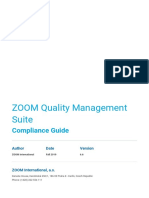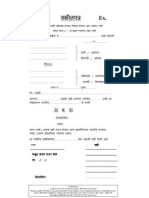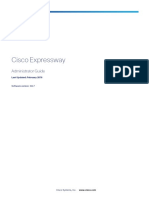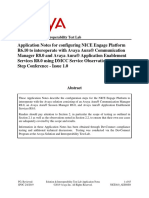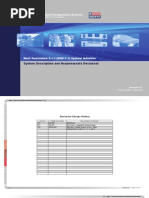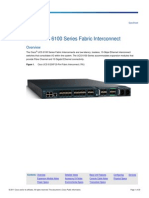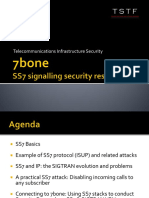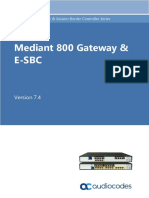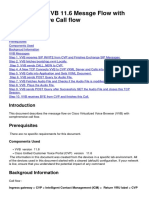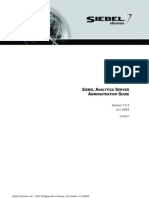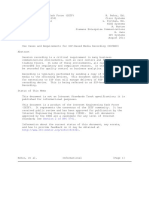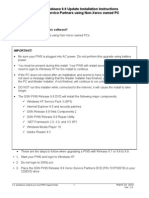Sip - Long Voip
Sip - Long Voip
Uploaded by
Quoc NhaCopyright:
Available Formats
Sip - Long Voip
Sip - Long Voip
Uploaded by
Quoc NhaOriginal Title
Copyright
Available Formats
Share this document
Did you find this document useful?
Is this content inappropriate?
Copyright:
Available Formats
Sip - Long Voip
Sip - Long Voip
Uploaded by
Quoc NhaCopyright:
Available Formats
hgs/SIP Tutorial 1
The Session Initiation Protocol
(SIP)
Henning Schulzrinne
Dept. of Computer Science
Columbia University
New York, New York
(sip:)schulzrinne@cs.columbia.edu
May 2001
hgs/SIP Tutorial 2
Overview
protocol architecture
typical component architectures
addressing and locating SIP entities
protocol operation and extensions
reliability
services, features and caller preferences
security and QoS
programming SIP services
May 2001
hgs/SIP Tutorial 3
Introduction
SIP = core protocol for establishing sessions in the Internet
transports session description information from initiator (caller) to callees
allows to change parameters in mid-session
terminate session
May 2001
hgs/SIP Tutorial 4
VoIP protocol architecture
Signaling
TLS
SCTP
IntServ DiffServ
SLP
Directory/Discovery
masterslave
RTSP
QoS Transport
SPIRITS
LDAP
DNS/enum TRIP
MGCP
H.248
RTP
Languages/APIs
voiceXML CPL
servlets
sipcgi
JAIN
Parlay
peertopeer
PINT
SIP
SDP
May 2001
hgs/SIP Tutorial 5
Multimedia protocol stack
media transport quality of service
measurement reservation
l
i
n
k
n
e
t
w
o
r
k
signaling
t
r
a
n
s
p
o
r
t
p
h
y
s
i
c
a
l
RTSP RSVP H.323
d
a
e
m
o
n
a
p
p
l
i
c
a
t
i
o
n
PPP
Sonet ATM
AAL3/4 AAL5 PPP
V.34
UDP
Ethernet
TCP
k
e
r
n
e
l
IPv4, IPv6
RTP
(H.261, MPEG)
media encaps.
RTCP
MGCP/Megaco
SIP
SDP
May 2001
hgs/SIP Tutorial 6
SIP protocol use
signaling
media
may
trigger
RTP
UDP
RTP
sets up
SDP
SIP
UDP
SIP
RSVP RSVP
SDP
LDAP
DNS
TRIP
address
lookup
PSTN gateway lookup
nexthop
May 2001
hgs/SIP Tutorial 7
SIP applications
setting up voice-over-IP calls
setting up multimedia conferences
event notication (subscribe/notify) IM and presence
text and general messaging
signaling transport
May 2001
hgs/SIP Tutorial 8
SIP addressing
May 2001
hgs/SIP Tutorial 9
Personal mobility
SIP uses email-style addresses to identify users
Alice.Cary@columbia.edu
tel:12015551234
alice@host.columbia.edu
tel:12128541111
alice@columbia.edu
7000@columbia.edu
alice@columbia.edu
alice17@yahoo.com
(also used by bob@columbia.edu)
yahoo.com
columbia.edu
May 2001
hgs/SIP Tutorial 10
SIP addressing
typically, same as users email address:
alice@example.com
12125551212@gateways-r-us.com
written as URL, e.g., sip:alice@example.com
can add parameters, such as type (user=phone) or transport protocol
May 2001
hgs/SIP Tutorial 11
tel URLs (RFC 2806)
also can use tel URLs for telephone numbers, e.g., tel:+12125551212 or
fax:+358.555.1234567
either global (tel:+1...) or local
(tel:0w003585551234567;phone-context=+3585551234 numbers
allow post-dialing digits: ;postd=pp32
also modem:+3585551234567;type=v32b?7e1;type=v110
May 2001
hgs/SIP Tutorial 12
SIP building blocks
SIP user agent IP phone, PC, conference bridge
SIP redirect server returns new location for requests
SIP stateless proxy routes call requests
SIP (forking) proxy routes call requests
A@
B@
C@
SIP registrar maintains mappings from names to addresses
May 2001
hgs/SIP Tutorial 13
Back-to-back UA (B2BUA)
two (or more) user agents, where incoming calls trigger outgoing calls to
somebody else
also, third-party call control (later)
useful for services and anonymity
SIP UA2 (UAC) SIP UA1 (UAS)
200 OK
INVITE callee
INVITE b2b
200 OK
May 2001
hgs/SIP Tutorial 14
Maintaining state in SIP entities
Stateless: each request and response handled indepdently
(Transaction) stateful: remember a whole request/response transaction
Call stateful: remember a call from beginning to end
May 2001
hgs/SIP Tutorial 15
SIP building block properties
media stateless stateful call state
UA (UAC, UAS) yes no unlikely common
proxy no yes common possible (rewall)
redirect registrar no no yes N/A
May 2001
hgs/SIP Tutorial 16
SIP architecture: peer-to-peer
RTP audio
CATV
Ethernet
128.119.40.186
SIP
redirect server
Internet
128.59.19.141
user agent (UA) user agent (UA)
user agent (UA)
May 2001
hgs/SIP Tutorial 17
SIP architecture: outbound proxy
wonderland.com
bob@p42.macrosoft.com
alice@ph7.wonderland.com
To: sip:bob@macrosoft.com
INVITE sip:bob@macrosoft.com SIP/2.0
INVITE sip:bob@p42.macrosoft.com SIP/2.0
INVITE sip:bob@macrosoft.com SIP/2.0
outbound
proxy
From: sip:bob@macrosoft.com
Contact: sip:bob@p42.macrosoft.com
REGISTER sip:macrosoft.com SIP/2.0
proxy
registrar
macrosoft.com
Internet
wonderland.com
May 2001
hgs/SIP Tutorial 18
SIP architecture: VoIP to PSTN
1 0 0
IP
H.248
SIP
location server
outbound proxy
sip:12125551234@domain
tel:+12125551234
SLP?, TRIPGW?
sip:12125551234@gwrus.com
TRIP
May 2001
hgs/SIP Tutorial 19
SIP architecture: PSTN to VoIP
1 0 0
IP
INVITE sip:alice@wonderland.com
DNS
enum SCP
4.3.2.1.5.5.5.2.1.2.1.e164.arpa
sip:alice@wonderland.com
enum database
May 2001
hgs/SIP Tutorial 20
SIP operation in proxy mode
9
media stream
4
8
7
1
INVITE
henning@columbia.edu
6
5
3
?
h
e
n
n
i
n
g
h
g
s
@
p
l
a
y
tune
play
cs.columbia.edu
200 OK
location server
200 OK
cz@cs.tuberlin.de
cs.tuberlin.de INVITE hgs@play
ACK hgs@play
2
May 2001
hgs/SIP Tutorial 21
SIP operation in redirect mode
1
4
3
2
6
7
8
5
?
h
e
n
n
i
n
g
ACK henning@ieee.org
INVITE henning@ieee.org
302 Moved temporarily
c
o
l
u
m
b
i
a
.
e
d
u
location
server
columbia.edu
hgs
tu-berlin.de
INVITE hgs@columbia.edu
200 OK
ACK hgs@columbia.edu
ieee.org
Contact: hgs@columbia.edu
(302: redirection for single call; 301 permanently)
May 2001
hgs/SIP Tutorial 22
Locating SIP users
May 2001
hgs/SIP Tutorial 23
Locating users: registrars and location servers
example.com
INVITE alice@pc17.example.com
SQL, LDAP, Corba,
proprietary, ...
location server
alice@example.com
alice@example.com
REGISTER
Contact:
alice@pc17
INVITE
proxy
registrar
B@
A@
C@
May 2001
hgs/SIP Tutorial 24
Basic user location mechanism
1. host(SIP URL) host name of proxy
2. DNS: host name of proxy SIP server(s)
3. if SIP UAS: alert user; done
4. if SIP proxy/redirect server: map URL
n
URL
n+1
, using any information in
request
5. go to step 1
One minor exception. . .
May 2001
hgs/SIP Tutorial 25
Basic SIP routing mechanisms
will ll in details later
route using request URIs
all but rst request in call typically bypass proxies and go direct UAC UAS
however, can use record-routing to force certain proxies to be visited all the time
responses always traverse the same route as requests
May 2001
hgs/SIP Tutorial 26
Outbound proxies
normally, proxy serves one or more domains
outbound proxies are used for all outbound requests from within a domain
typically, for managing corporate rewalls and policy enforcement
may also provide dial plans or route tel/fax URLs
other uses: lawyer client billing, . . .
May 2001
hgs/SIP Tutorial 27
Locating users: DNS SRV
email: DNS MX record allows mapping of domain to mail host, e.g.
host -t mx yahoo.com
yahoo.com MX 1 mx2.mail.yahoo.com
yahoo.com MX 1 mx3.mail.yahoo.com
yahoo.com MX 1 mx1.mail.yahoo.com
yahoo.com MX 9 mta-v1.mail.yahoo.com
SIP: use a newer record for general-purpose mapping, SRV (RFC 2782)
mapping from service and transport protocol to one or more servers, including
protocols
_sip._tcp SRV 0 0 5060 sip-server.cs.columbia.edu.
SRV 1 0 5060 backup.ip-provider.net.
_sip._udp SRV 0 0 5060 sip-server.cs.columbia.edu.
SRV 1 0 5060 backup.ip-provider.net.
allows priority (for back-up) and weight (for load balancing)
May 2001
hgs/SIP Tutorial 28
Using DNS SRV for scalable load-balancing
b1.example.com, b2.example.com
a1.example.com, a2.example.com
sip:bob@a.example.com
SRV 0 0 s3.example.com
sip:bob@example.com
s3.example.com
s2.example.com
s1.example.com
_sip._udp SRV 0 0 s1.example.com
SRV 0 0 s2.example.com
a.example.com
SRV 1 0 a2.example.com
_sip._udp SRV 0 0 a1.example.com
b*@example.com
a*@example.com
May 2001
hgs/SIP Tutorial 29
Aside: SIP scaling
HTTP request director SIP client-based
HTTP randomized DNS (short TTL!) SRV weights and priorities
cant just distribute requests randomly, since backend (registration)
synchronization is needed
registration scaling: requests/second * 3600; e.g., 100 requests/second 360,000
users/server
major bottlenecks are logging and database updates
generally, higher registration than INVITE rates
May 2001
hgs/SIP Tutorial 30
SIP protocol operation
May 2001
hgs/SIP Tutorial 31
SIP requests and responses
text, not binary, format
look very similar to HTTP/1.1
requests and responses are similar except for rst line
requests and responses can contain message bodies: typically session descriptions,
but also ASCII or HTML
May 2001
hgs/SIP Tutorial 32
SIP syntax
m
e
s
s
a
g
e
h
e
a
d
e
r
m
e
s
s
a
g
e
b
o
d
y
response request
message
t=0 0
m= media type port RTP/AVP
host
c=IN IP4 media destination address
V=0
method URL SIP/2.0
From:
payload types
To:
CSeq: seq# method
localid@host
user <sip:to_user@destination>
user <sip:from_user@source>
Header: parameter ;par1=value ;par2="value"
media type of body
length of body ContentLength:
ContentType:
Via: SIP/2.0/ protocol host:port
SIP/2.0 status reason
IN IP4 origin_user timestamp timestamp
CallID:
;par3="value folded into next line"
o=
blank line
May 2001
hgs/SIP Tutorial 33
SIP syntax
eld names and some tokens (e.g., media type) are case-insensitive
everything else is case-sensitive
white space doesnt matter except in rst line
lines can be folded
multi-valued header elds can be combined as a comma-list
May 2001
hgs/SIP Tutorial 34
SIP methods
INVITE initiate call
ACK conrm nal response
BYE terminate (and transfer) call
CANCEL cancel searches and ringing
OPTIONS features support by other side
REGISTER register with location service
INFO mid-call information (ISUP)
COMET precondition met
PRACK provisional acknowledgement
SUBSCRIBE subscribe to event
NOTIFY notify subscribers
REFER ask recipient to issue SIP request (call transfer)
May 2001
hgs/SIP Tutorial 35
SIP invitation and media negotiation
calls alice@wonderland.com
accept audio, decline video
bob@macrosoft.com
CallID: 31415@wonderland.com
CSeq: 42 INVITE
ContentType: application/sdp
v=0
c=IN IP4 h3.wonderland.com
m=audio 3456 RTP/AVP 0 1
m=video 4000 RTP/AVP 38 39
From: sip:alice@wonderland.com
INVITE sip:bob@macrosoft.com SIP/2.0
CallID: 31415@wonderland.com
ContentType: application/sdp
v=0
SIP/2.0 200 OK
o=user1 536 2337 IN IP4 h3.wonderland.com o=user1 535 687637 IN IP4 m.macrosoft.com
c=IN IP4 m.macrosoft.com
m=audio 1200 RTP/AVP 1
m=video 0 RTP/AVP
To: sip:bob@macrosoft.com
From: sip:alice@wonderland.com
CSeq: 42 INVITE
To: sip:bob@macrosoft.com
May 2001
hgs/SIP Tutorial 36
Tagging To
after forking and merging, hard to tell who responded
UAS responds with random tag added to disambiguate
To: "A. G. Bell" <sip:agb@bell-telephone.com>
;tag=a48s
future requests are ignored if they contain the wrong tag
May 2001
hgs/SIP Tutorial 37
SIP call legs
call leg: From, To, Call-ID
requests from callee to caller reverse To and From
caller and callee keep their own CSeq space
either side can send more INVITEs or BYE
May 2001
hgs/SIP Tutorial 38
SIP responses
Informational Redirection
Global Failure Server Failure
Success Request Failure
604 Doesnt Exist
606 Not Acceptable
603 Decline
100 Trying
180 Ringing
181 Call forwarded
182 Queued
183 Session Progress
200 OK
301 Moved Perm.
302 Moved Temp.
380 Alternative Serv.
400 Bad Request
401 Unauthorized
403 Forbidden
404 Not Found
405 Bad Method
415 Unsupp. Content
420 Bad Extensions
486 Busy Here
300 Multiple Choices
600 Busy Everwhere
504 Timeout
503 Unavailable
501 Not Implemented
500 Server Error
May 2001
hgs/SIP Tutorial 39
SIP response routing
requests are routed via URL
response traces back request route without proxy server state
forward to host, port in next Via
TCP: re-use connection if possible, create new one if needed
UDP: may send responses to same port as requests
Via: SIP/2.0/UDP server.domain.org:5060
;received=128.1.2.3
May 2001
hgs/SIP Tutorial 40
SIP response routing
alice@example.com bob@columbia.edu bob_doe@yahoo.com
bob@pc42.cs.columbia.edu
Via: sip.columbia.edu
Via: cs.columbia.edu
Via: y1.yahoo.com
Via: a.example.com
Via: cs.columbia.edu
Via: sip.columbia.edu
Via: y1.yahoo.com
Via: a.example.com
Via: sip.columbia.edu
Via: y1.yahoo.com
Via: a.example.com
Via: a.example.com
Via: y1.yahoo.com
Via: a.example.com
Via: a.example.com
Via: y1.yahoo.com
Via: a.example.com
Via: y1.yahoo.com
Via: sip.columbia.edu
bob@cs.columbia.edu
200 OK
Via: a.example.com
INvITE
May 2001
hgs/SIP Tutorial 41
SIP spirals
h(info,alice,17,1,info)
h(info,alice,17,1,info)
alice@ph123.wonderland.com
h(info,alice,17,1,bob@sales)
h(info,alice,17,1,kelly@acme)
acme.com
h(info,alice,17,1,bob@sales)
h(To,From,CallID,CSeq,URL)
h(info,alice,17,1,bob@sales)
h(info,alice,17,1,info)
h(info,alice,17,1,bob@sales)
h(info,alice,17,1,kelly@acme)
sales.acme.com
h(info,alice,17,1,kelly@sales)
branch=
INVITE sip:bob@sales.acme.com SIP/2.0
Via: acme.com;branch=
Via: ph123.wonderland.com
Via: acme.com;branch=
Via: ph123.wonderland.com
Via: ph123.wonderland.com
INVITE sip:kelly@acme.com SIP/2.0
INVITE sip:info@acme.com SIP/2.0
Via: sales.acme.com;branch=
To: sip:info@acme.com
INVITE sip:kelly@p4711.sales.acme.com SIP/2.0
Via: ph123.wonderland.com
Via: acme.com;branch=
Via: ph123.wonderland.com
Via: acme.com;branch=
Via: sales.acme.com;branch=
Via: acme.com;branch=
Via: sales.acme.com;branch=
INVITE sip:kelly@sales.acme.com SIP/2.0
Via: acme.com;branch=
Via: sales.acme.com;branch=
May 2001
hgs/SIP Tutorial 42
Forcing request paths
usually, bypass proxies on subsequent requests
some proxies want to stay in the path call-stateful:
rewalls
anonymizer proxies
proxies controlling PSTN gateways
use Record-Route and Route
May 2001
hgs/SIP Tutorial 43
Request routing
Route: A;maddr=PB
Route: A;maddr=PA
Route: A;maddr=A
INVITE PB INVITE PB INVITE B
Contact: A
RecordRoute: PB, PA
Contact: A
200 OK
Contact: B
RecordRoute: PB, PA
200 OK
Contact: B
RecordRoute: PB, PA
200 OK
Contact: B
RecordRoute: PB, PA
ACK PA
Route: PB,B
ACK PB
Route: B
ACK B
BYE A BYE A
Route: A;maddr=PB
BYE A
A PA PB B
Contact: A
RecordRoute: PA
May 2001
hgs/SIP Tutorial 44
SIP request forking
INVITE sales@macrosoft.com
carol@c.macrosoft.com
INVITE bob@b
bob@b.macrosoft.com
200 OK
INVITE carol@c
ACK
BYE carol@c.macrosoft.com
200 OK
a.wonderland.com
macrosoft.com
CANCEL bob@c
May 2001
hgs/SIP Tutorial 45
SIP sequential request forking
Use q values to govern order of sequential search:
INVITE
3
1
2
200 OK
q=0.1
486 Busy here
q=0.7
302 Moved temporarily
q=1.0
May 2001
hgs/SIP Tutorial 46
SIP request forking
branches tried in sequence or parallel (or some combination)
recursion: may try new branches if branch returns 3xx
return best nal answer = lowest status code
forward provisional responses
May 2001
hgs/SIP Tutorial 47
Parallel forking call ow
UAS proxy server
100 Trying
UAC
UAS
INVITE bob@portal
bob@portal
180 Ringing
200 OK
alice
bob@home bob@work
CANCEL bob@work
ACK bob@work
ACK bob@home
487 Cancelled (INVITE)
200 OK (CANCEL)
Contact: bob@home
200 OK
May 2001
hgs/SIP Tutorial 48
SIP transport issues
SIP operates over any packet network, reliable or unreliable
choices:
UDP: most common
low state overhead
small max. packet size
TCP: can combine multiple signaling ows over one link
use with SSL
connection setup overhead
HOL blocking for trunks
SCTP: new protocol
no HOL blocking
fallback address (but SRV provides this already)
connection setup overhead
May 2001
hgs/SIP Tutorial 49
Transport reliability for all but INVITE
used for BYE, OPTIONS,
SUBSCRIBE, NOTIFY, . . .
1xx sent by UAS or proxy
only if no nal answer ex-
pected within 200 ms
if provisional response, re-
transmit with T2 (4) seconds
500 ms
1 s
2 s
4 s
4 s
...
BYE
UAS, proxy client
200, 4xx, 5xx, 6xx
no more than
11 packets
May 2001
hgs/SIP Tutorial 50
INVITE reliability
INVITE is special long time
between request and nal re-
sponse
100 (by proxy) indicates re-
quest has been received
proxy usually forwards 1xx
from all branches
only retransmit until 100
ACK conrms receipt of nal
response
ACK
status
INVITE
ACK
ACK
status
status
request sent
event
Calling
Initial
1xx
1xx
Call proceeding
INVITE
T1*2
n
7 INVITE sent
Completed
May 2001
hgs/SIP Tutorial 51
Other signaling approaches
May 2001
hgs/SIP Tutorial 52
Differences to classical signaling
name examples network channel
in-band E&M, DTMF same same
out-of-band ISUP, Q.931 different different
IP SIP typically same different
IP signaling meets media only at end systems, while PSTN out-of-band intersects at
every switch
May 2001
hgs/SIP Tutorial 53
Aside: Alternative architecture: master-slave
master-slave: MGC (media gateway controller) controls one or more gateways
allows splitting of signaling and media functionality
please send audio from circuit 42 to 10.1.2.3
uses MGCP (implemented) or Megaco/H.248 (standardized, but just beginning to
be implemented)
gateway can be residential
basis of PacketCable NCS (network control system) architecture
service creation similar to digital PBX or switch
end system has no semantic knowledge of whats happening
can charge for caller id, call waiting
May 2001
hgs/SIP Tutorial 54
MGCP/SIP architecture
MGCP/Megaco SS7
SIP SIP
H.323 H.323 ISUP
MGCP/Megaco
TCAP
RTP
TGW
SCP
STP
RGW
RGW
MG controller
SS7 gwy
call agent call agent
MG controller
Internet
PSTN
May 2001
hgs/SIP Tutorial 55
Extending SIP
extension behavior determine?
new headers ignored
new headers mandatory Supported
new method OPTIONS
new body type Accept
new status code class-based
new URL type ?
May 2001
hgs/SIP Tutorial 56
SIP extensions and feature negotiation
if crucial, mark with Require: feature
IANA-registered features are simple names, private features use reverse domain
names
indicate features supported in Supported:
C->S: INVITE sip:watson@bell-telephone.com SIP/2.0
Require: com.example.billing
Supported: 100rel
Payment: sheep_skins, conch_shells
S->C: SIP/2.0 420 Bad Extension
Unsupported: com.example.billing
S->C: SIP/2.0 421 Extension Required
Require: 183
May 2001
hgs/SIP Tutorial 57
User identication
May 2001
hgs/SIP Tutorial 58
Standard call/caller identication
Request-URI: next hop
To: logical call destination
From: logical call origin
Organization: organization of caller/callee
Subject: subject of call
Call-Info: additional information about caller or callee
Call-Info:
<http://wwww.example.com/alice/photo.jpg> ;purpose=icon,
<http://www.example.com/alice/> ;purpose=info
User-Agent: make and model of user agent
May 2001
hgs/SIP Tutorial 59
Additional call information
Priority: call priority: emergency, urgent, normal, non-urgent
Alert-Info: render instead of ring tone
Alert-Info: <http://wwww.example.com/sounds/moo.wav>
In-Reply-To: call-id being returned
May 2001
hgs/SIP Tutorial 60
draft-ietf-sip-privacy
To/headerFrom are chosen by end system may lie
need privacy indications similar to caller id
Remote-Party-ID: "John Doe"
<sip:jdoe@foo.com>;party=calling;
id-type=subscriber;privacy=full
screen=yes: was veried by proxy
type can be subscriber, user, alias, return (calls), term (terminal)
may add geographic user location
May 2001
hgs/SIP Tutorial 61
SIP services
May 2001
hgs/SIP Tutorial 62
Invitation modes
signaling media
unicast multicast
unicast telephony multicast session
multicast reach rst dept. conference
SIP for all modes, SAP/SDP also for multicast/multicast
May 2001
hgs/SIP Tutorial 63
SIP-based services
Call forwarding: basic INVITE behavior (proxy/redirect)
Call transfer: REFER method (see later)
Call hold: set media address to 0.0.0.0 can be done individually per media
Caller id: From, plus extensions
DTMF carriage: carry as RTP payload (RFC 2833)
Calling card: B2BUA + voice server
Voice mail: UA with special URL(s) + possibly RTSP
May 2001
hgs/SIP Tutorial 64
Call transfer
3
A
B1
B2
INVITE B2
ReferredBy: B1
2
ReferredBy: B1
REFER B2
1
BYE A
May 2001
hgs/SIP Tutorial 65
IVR and VoiceXML
VoiceXML
text
text
A@
B@
C@
SIP UA SIP
SQL, LDAP
REFER
200
RTP
VoiceXML
scripts
May 2001
hgs/SIP Tutorial 66
Third-party call control
RTP
SIP
SIP
2
4
INVITE
ACK
no SDP 1
6
3
INVITE
5
SDP (from 4)
SDP (from 2)
ACK
200
200
May 2001
hgs/SIP Tutorial 67
SIP billing/charging
What for?
transport resource reservation
protocol
SIP services (call processing)
authentication
PSTN gateway services
media server services (translation,
storage)
How?
resource reservation protocols
SIP-in-DIAMETER approach
server log les
May 2001
hgs/SIP Tutorial 68
Security issues
May 2001
hgs/SIP Tutorial 69
Threats
spoong From in REGISTER: call redirection
spoong From in INVITE: bypass call ltering
snooping media packets
billing confusion (identier munging)
denial-of-service attacks
May 2001
hgs/SIP Tutorial 70
SIP security
layer/mechanism approach characteristics
network layer IPsec adjacent nodes, all or nothing, hard to congure
transport layer TLS adjacent nodes, all or nothing
SIP INVITE basic/digest shared secrets with random parties
SIP REGISTER basic/digest securing headers?
SIP general S/MIME in progress
Basic (plaintext password) and digest (challenge-response) are very similar to HTTP
security mechanisms.
May 2001
hgs/SIP Tutorial 71
SIP authentication
Basic: include plain-text password in request, immediately or after 401
(Unauthorized) or 407 (Proxy Authorization) response
Digest: challenge-response with shared secret
Certicate: sign non-Via parts of request headers, body with PGP, PKCS #7
SSL, SSH: but only for TCP
but: need more elaborate cryptographic capability indication in SDP
May 2001
hgs/SIP Tutorial 72
Basic authentication
Challenge by UAS:
SIP/2.0 401 Unauthorized
WWW-Authenticate: Basic realm="business"
client responds with
INVITE sip:alice@wonderland.com SIP/2.0
CSeq: 2 INVITE
Authorization: QWxhZGRpbjpvcGVuIHNlc2FtZQ==
where authorization is base64(userid:password)
usually caller callee, but challenge can be in request
May 2001
hgs/SIP Tutorial 73
Digest authentication
A calls B and fails:
SIP/2.0 401 Unauthorized
Authenticate: Digest realm="GW service",
domain="wcom.com",
nonce="wf84f1ceczx41ae6cbe5aea9c8e88d359",
opaque="42", stale="FALSE", algorithm="MD5"
A tries again:
INVITE sip:UserB@ss1.wcom.com SIP/2.0
Authorization:Digest username="UserA",
realm="GW service",
nonce="wf84f1ceczx41ae6cbe5aea9c8e88d359",
opaque="42", uri="sip:UserB@ss1.wcom.com",
response="42ce3cef44b22f50c6a6071bc8"
May 2001
hgs/SIP Tutorial 74
Digest authentication
username: user authenticating herself
realm: several per user, used also for display
nonce: copied into Authorization
opaque: copied into Authorization
uri: original request URL
response: 32 hex digits:
KD (H(A
1
), nonce-value : H(A
2
))
for MD5: H(H(A
1
) : nonce-value : H(A
2
)))
where A
1
= username : realm : passwd
A
2
= method : uri
May 2001
hgs/SIP Tutorial 75
Quality of Service
May 2001
hgs/SIP Tutorial 76
Quality of service
SIP and data paths disjoint SIP cant reserve resources
but: SDP may provide information to end systems on desired QoS
SDP contains range of codecs to allow mid-call adaptation
May 2001
hgs/SIP Tutorial 77
Interaction with resource reservation
avoid fast busy after ringing interleave
UAC
PRACK
PRACK
180 Ringing
reservation
INVITE alice@ieee.org
200 OK (PRACK)
UAS
ACK (INVITE)
200 OK (INVITE)
200 OK (PRACK)
183 Session Progress (SDP)
200 (COMET)
COMET
May 2001
hgs/SIP Tutorial 78
SIP Caller Preferences
May 2001
hgs/SIP Tutorial 79
Preferences
callee: scripts, CPL, REGISTER advice in Contact, . . .
caller: help guide routing (no home number) and order of attempts when forking
(try videophone rst, then phone, then answering service)
caller proposes, callee disposes
May 2001
hgs/SIP Tutorial 80
Extended SIP Contact header
q location preference
class business, residence
description show to caller
duplex full or half-duplex
feature call handling features
language languages spoken
media audio, video, text/numeric, . . .
mobility xed or mobile
priority only in case of emergency
scheme URL schemes (tel, http, . . . )
service IP, PSTN, ISDN, pager, . . .
May 2001
hgs/SIP Tutorial 81
Contact example
q=quality gives preference.
SIP/2.0 302 Moved temporarily
Contact: sip:hgs@erlang.cs.columbia.edu
;action=redirect ;service=IP,voice-mail
;media=audio ;duplex=full ;q=0.7;
Contact: tel:+1-415-555-1212 ; service=ISDN
;mobility=fixed ;language=en,es,iw ;q=0.5
Contact: tel:+1-800-555-1212 ; service=pager
;mobility=mobile
;duplex=send-only;media=text; q=0.1; priority=urgent;
;description="For emergencies only"
Contact: mailto:hgs@cs.columbia.edu
May 2001
hgs/SIP Tutorial 82
Accept-Contact and Reject-Contact
determine order of contacting users:
Accept-Contact: sip:sales@acme.com ;q=0,
;media="!video" ;q=0.1,
;mobility="fixed" ;q=0.6,
;mobility="!fixed" ;q=0.4
avoid connecting me to sales; I prefer a landline phone; try
Reject-Contact: rule out destinations
Reject-Contact: ;class=personal
May 2001
hgs/SIP Tutorial 83
Request-Disposition
proxy or redirect
cancel ringing second phone after rst picked up?
allow forking?
search recursively?
search sequentially or in parallel?
queue the call?
Request-Disposition: proxy, recurse, parallel
May 2001
hgs/SIP Tutorial 84
SIP presence, events and instant
messaging
May 2001
hgs/SIP Tutorial 85
SIP presence architecture
NOTIFY
example.com
alice@
macrosoft.com
SUBSCRIBE
NOTIFY
REGISTER
PA
bob
UA
PA
PUA
PUA
PUA
presentity
presence server
registrar
May 2001
hgs/SIP Tutorial 86
SIP presence components
Presentity: logical entity being subscribe to, e.g., alice@wonderland.com, with
several agents
Registrar: receives REGISTER requests
Presence user agent (PUA): generates REGISTER, but no SUBSCRIBE or
NOTIFY any non-presence-aware SIP software
Presence agent: receive SUBSCRIBE, generate NOTIFY
Presence server: SIP proxy + PA
Presence client: SIP UA + PA
May 2001
hgs/SIP Tutorial 87
SIP presence protocol
200 OK
200 OK
200 OK
NOTIFY alice
NOTIFY alice
subcriber
alice
presentity, PA
bob
SUBSCRIBE bob
Event: presence
From: alice
To: bob
bob available
bob not
available
May 2001
hgs/SIP Tutorial 88
SIP SUBSCRIBE example
SUBSCRIBE sip:bob@macrosoft.com SIP/2.0
Event: presence
To: sip:bob@macrosoft.com
From: sip:user@example.com
Contact: sip:user@userpc.example.com
Call-ID: knsd08alas9dy@3.4.5.6
CSeq: 1 SUBSCRIBE
Expires: 3600
Content-Length: 0
Forked to all PUAs that have REGISTERed with method SUBSCRIBE.
200 (OK) response contains current state.
May 2001
hgs/SIP Tutorial 89
SIP NOTIFY example
NOTIFY sip:user@userpc.example.com
To: sip:user@example.com
From: sip:alice@wonderland.com
Call-ID: knsd08alas9dy@3.4.5.6
CSeq: 1 NOTIFY
Content-Type: application/xpidf+xml
<?xml version="1.0"?>
<!DOCTYPE presence
PUBLIC "-//IETF//DTD RFCxxxx XPIDF 1.0//EN" "xpidf.dtd">
<presence>
<presentity uri="sip:alice@wonderland.com;method="SUBSCRIBE">
<atom id="779js0a98">
<address uri="sip:alice@wonderland.com;method=INVITE">
<status status="closed"/>
</address>
</atom>
</presentity>
</presence>
May 2001
hgs/SIP Tutorial 90
SIP events
single-valued (light-switch) to complex (CD changer) to multi-valued
(temperature samples)
both built-in and mediated (X10)
often combined with audio/video in same system: security, industrial control,
home entertainment
notication rates vary gradual transition to continuous media
100 10 1 0.1 0.01
IR detector
control audio/video
sensor
temperature process packet
events (packets) / second
Event describes event type
May 2001
hgs/SIP Tutorial 91
Example home architecture
SUBSCRIBE door@alice.home.net
NOTIFY alice@work.com
INVITE camera@alice.home.net
DO light@alice.home.net
SIP user agent
SIP proxy
(RGW)
(Work with Telcordia)
May 2001
hgs/SIP Tutorial 92
SIP IM
send text or any other MIME type
either as SDP-initiated session or as individual messages
use MESSAGE
May 2001
hgs/SIP Tutorial 93
Programming SIP Services
May 2001
hgs/SIP Tutorial 94
Programming SIP services
safety language? party?
SIP-cgi same as scripting any callee
servlets same as Java Java callee
CPL very XML both
applets same as Java Java caller
May 2001
hgs/SIP Tutorial 95
Programming services
caller proposes, callee disposes, administrator decides
web = static pages cgi-bin Java
if somebody is trying to call for the 3rd time, allow mobile
try ofce and lab in parallel, if that fails, try home
allow call to mobile if Ive talked to person before
if on telemarketing list, forward to dial-a-joke
phone: CTI = complex, not generally for end users
May 2001
hgs/SIP Tutorial 96
cgi-bin for SIP Servers
extend SIP user/proxy/redirect server functionality without changing server
software
server manages retransmission, loop detection, authentication, . . .
Perl, Tcl, VB scripts
May 2001
hgs/SIP Tutorial 97
Examples
Call forward on busy/no answer
Administrative screening (rewall)
Central phone server
Intelligent user location
Third-party registration control
Calendarbook access
Client billing allocation (lawyers
ofce)
End system busy
Phone bank (call distribu-
tion/queueing)
May 2001
hgs/SIP Tutorial 98
cgi Script Functionality
called for any method except ACK or CANCEL
proxying of requests
returning responses
generate new requests
once for each request or response or timeout
May 2001
hgs/SIP Tutorial 99
cgi Script Mechanism
environment variables: headers, methods, authenticated user, . . .
stdin: body of request
stdout: new request, meta-requests:
CGI- requests for proxying, response, default action
script cookie for state across messages
reexecute on all, nal response, never
May 2001
hgs/SIP Tutorial 100
Cgi Example: Call Forwarding
use DB_File;
sub fail {
my($status, $reason) = @_;
print "SIP/2.0 $status $reason\n\n";
exit 0;
}
tie %addresses, DB_File, addresses.db
or fail("500", "Address database failure");
$to = $ENV{HTTP_TO};
if (! defined( $to )) {
fail("400", "Missing Recipient");
}
May 2001
hgs/SIP Tutorial 101
$destination = $addresses{$to};
if (! defined( $destination )) {
fail("404", "No such user");
}
print "CGI-PROXY-REQUEST-TO $destination SIP/2.0\n";
print "CGI-Reexecute-On: never\n\n";
untie %addresses; # Close db file
May 2001
hgs/SIP Tutorial 102
The Call Processing Language
Jonathan Lennox
Columbia University
lennox@cs.columbia.edu
May 5, 2000
May 2001
hgs/SIP Tutorial 103
Purpose
Allow users to create simple Internet telephony services
Features:
Creatable and editable by simple graphical tools
Independent of signalling protocol
Safe to run in servers
May 2001
hgs/SIP Tutorial 104
Abstract structure
String-switch
field: from
match:
*@example.com
otherwise
proxy
timeout: 10s
location
url: sip:jones@
example.com
voicemail.
merge: clear
location
url: sip:jones@
example.com
redirect
Call
busy
timeout
failure
May 2001
hgs/SIP Tutorial 105
Abstract structure (cont)
Nodes and outputs boxes and arrows
Nodes have parameters
Start from single root call node
Progress down tree of control
May invoke sub-actions
Follow one output of each node, based on outcome
Continue until we get to a node with no outputs
May 2001
hgs/SIP Tutorial 106
Textual representation
<cpl>
<subaction id="voicemail">
<location url="sip:jones@voicemail.example.com">
<redirect />
</location>
</subaction>
May 2001
hgs/SIP Tutorial 107
Textual representation
<incoming>
<address-switch field="origin" subfield="host">
<address subdomain-of="example.com">
<location url="sip:jones@example.com">
<proxy>
<busy> <sub ref="voicemail" /> </busy>
<noanswer> <sub ref="voicemail" /> </noanswer>
<failure> <sub ref="voicemail" /> </failure>
</proxy>
</location>
</address>
<otherwise>
<sub ref="voicemail" />
</otherwise>
</address-switch>
</incoming>
</cpl>
May 2001
hgs/SIP Tutorial 108
Textual representation
Represent scripts as XML documents
Incoming, outgoing scripts are separate top-level tags
Nodes and outputs are both tags
Parameters are tag attributes
Multiple outputs to one input represented by subactions
May 2001
hgs/SIP Tutorial 109
Switch nodes
Switch nodes make decisions.
Structure:
<type-switch field=var>
<type condition1="value1">
action1
</type>
<type condition2="value2">
action2
</type>
<not-present>
action3
<otherwise>
action4
</otherwise>
</type-switch>
May 2001
hgs/SIP Tutorial 110
Address Switches: address
Switch based on textual strings:
is: (exact string match)
contains: substring match: only for display
subdomain-of: domain match: only for host, tel
Fields are origin, destination, original-destination, with subelds address-type,
user, host, port, tel, display
May 2001
hgs/SIP Tutorial 111
String Switches: string
Switch based on textual strings, with conditions:
is: exact string match
contain: substring match
Fields: subject, organization, user-agent
May 2001
hgs/SIP Tutorial 112
Time switches: time
Switch based on the current time at the server.
timezone: which timezone the matching should apply in
Conditions:
year, month, date, day, timeofday
each condition is a list of ranges: a
1
b
1
, a
2
b
2
, . . .
must fall within a range of all specied conditions
May 2001
hgs/SIP Tutorial 113
Time switches: examples
<time month="12" date="25" year="1999">
December 25th, 1999, all day
<time month="5" date="4">
May 4th, every year, all day
<time day="1-5" timeofday="0900-1700">
9 AM 5 PM, Monday through Friday, every week
May 2001
hgs/SIP Tutorial 114
Time switches: examples
<time timeofday="1310-1425,1440-1555,1610-1725"
day="2,4">
1:10 2:25 PM, 2:40 3:55 PM, and 4:10 5:25 PM, Tuesdays and Thursdays,
every week
<time date="1-7" day="1">
The rst Monday of every month, all day
May 2001
hgs/SIP Tutorial 115
Location nodes
A number of CPL actions (proxy, redirect) take locations
Location nodes let you specify them
These are full-featured nodes because we might want to make decisions based on
outcomes of location lookups, or cascade locations
A CPL script has an implicit global list of locations
Location nodes can add to this list, or clear the list
May 2001
hgs/SIP Tutorial 116
Simple location nodes: location
Specify a location explicitly.
url: explicitly specied location
clear: clear earlier location values
Only one output; cannot fail. Dont use an explicit output node in the URL.
May 2001
hgs/SIP Tutorial 117
Location lookup nodes: lookup
Specify a location abstractly, by where it should be looked up.
Parameters:
source: URL (ldap, http (CGI), etc) or non-URL source (registration) to search for
locations
timeout: time to wait
use/ignore: use: caller-preferences parameters to use
ignore: caller-preferences parameters to disregard
merge:
Outputs: success, notfound, failure
May 2001
hgs/SIP Tutorial 118
Location removal nodes: remove-location
Remove locations from the location set, based on caller preferences/callee capabilities.
Has the same effect as a Reject-Contact header.
param: caller preference parameters to apply
value: values of parameters specied in param
location: caller preference location to apply
May 2001
hgs/SIP Tutorial 119
Signalling Actions: proxy
Proxy the call to the currently-specied set of locations, and automatically select one
best nal response.
timeout: time before giving up on the proxy attempt
recurse: recurse on redirect responses to the proxy attempt?
ordering: try location in parallel, sequential, rst-only
Outputs: busy, noanswer, failure
If the proxy attempt was successful, script terminates
May 2001
hgs/SIP Tutorial 120
Signalling Actions: redirect
Redirect the call to the currently-specied set of locations. This has no specic
parameters, and causes the script to terminate.
May 2001
hgs/SIP Tutorial 121
Signalling Actions: reject
Reject the call attempt. This causes the script to terminate.
status: busy, notfound, reject, or error, or a 4xx, 5xx, or 6xx code (for SIP).
reason: string explaining the failure.
May 2001
hgs/SIP Tutorial 122
Non-signalling action: mail
Notify a user of something through e-mail.
url: the address to contact, including any header parameters.
May 2001
hgs/SIP Tutorial 123
Non-signalling action: log
Store a record of the current call in a log.
name: the name of the log this should be stored
omment: a string explaining the log entry
Outputs: success, failure
May 2001
hgs/SIP Tutorial 124
Subactions
XML syntax denes a tree; we want CPLs to be represented as directed acyclic
graphs.
Subactions are dened at the top level of the script, outside other actions.
for acyclicity, top-level actions and subactions may only call subactions which
were dened earlier in the script.
Anywhere a node is expected, you can instead have a sub tag, with a ref
parameter which refers to a subactions id.
May 2001
hgs/SIP Tutorial 125
Example: Call Redirect Unconditional
<cpl>
<incoming>
<location url="sip:smith@phone.example.com">
<redirect />
</location>
</incoming>
</cpl>
May 2001
hgs/SIP Tutorial 126
Example: Call Forward Busy/No Answer
<cpl>
<subaction id="voicemail">
<location url="sip:jones@voicemail.example.com" >
<proxy />
</location>
</subaction>
<incoming>
<location url="sip:jones@jonespc.example.com">
<proxy timeout="8s">
<busy>
</busy>
<noanswer>
<sub ref="voicemail" />
</noanswer>
</proxy>
</location>
</incoming>
</cpl>
May 2001
hgs/SIP Tutorial 127
Example: Call Screening
<cpl>
<incoming>
<address-switch field="origin" subfield="user">
<address is="anonymous">
<reject status="reject"
reason="I dont accept anonymous calls" />
</address>
</address-switch>
</incoming>
</cpl>
May 2001
hgs/SIP Tutorial 128
Example: Time-of-day Routing
<?xml version="1.0" ?>
<!DOCTYPE call SYSTEM "cpl.dtd">
<cpl>
<incoming>
<time-switch timezone="US/Eastern">
<time day="1-5" timeofday="0900-1700">
<lookup source="registration">
<success>
<proxy />
</success>
</lookup>
</time>
<otherwise>
<location url="sip:jones@voicemail.example.com">
<proxy />
</location>
</otherwise>
</time-switch>
</incoming>
</cpl>
May 2001
hgs/SIP Tutorial 129
Example: Non-call Actions
<?xml version="1.0" ?>
<!DOCTYPE call SYSTEM "cpl.dtd">
<cpl>
<incoming>
<lookup source="http://www.example.com/cgi-bin/locate.cgi?user=jones"
timeout="8">
<success>
<proxy />
</success>
<failure>
<mail url="mailto:jones@example.com&Subject=lookup%20failed" />
</failure>
</lookup>
</incoming>
</cpl>
May 2001
hgs/SIP Tutorial 130
SIP for Third-Generation Wireless
Networks
May 2001
hgs/SIP Tutorial 131
3G networks
successor to 2G mobile networks: GSM (TDMA) and IS-95 (CDMA) in 900/1800
MHz range
2.5G: GSMGPRS EDGE
use different air interfaces in 2 GHz range: W-CDMA, CDMA 2000, TD-CDMA
3GPP standardizes for W-CDMA (GSM follow-on), while 3GPP2 does CDMA
2000
identied by releases (1999, R4, R5)
May 2001
hgs/SIP Tutorial 132
3G and VoIP
GPRS not suitable for VoIP: low bandwidth, high delay (500-600 ms RTT)
initially (R4), CS voice to base station, then ATM/IP packets
later (R5), in Internet multimedia (IM) subsystem IP to UE (user equipment)
uses AMR audio codec, with variable rate of 4.75 to 12.2 kb/s, or GSM HR or EFR
UTRAN delays: see TR 25.932
May 2001
hgs/SIP Tutorial 133
Signaling in 3GPP IM subsystem
Uses SIP for session setup and denes new entities:
Proxy CSCF: rst point of contact in visited network; nds the users home network
and provide some translation, security and authorization functions
Serving CSCF: controls sessions, acts as registrar and triggers and executes services.
Accesses the users prole; can be located in the home or visited network.
Interrogating CSCF: rst point of contact in home network. It assigns the serving
CSCF, contacts the HSS and forwards SIP request.
May 2001
hgs/SIP Tutorial 134
3G SIP registration
visited IM domain
home IM domain
serving
CSCF
interrogating
proxy
interrogating
mobility management
signaling
registration signaling (SIP)_
May 2001
hgs/SIP Tutorial 135
Differences to standard SIP
requires REGISTER before making call
INVITE uses authentication information provided by REGISTER Path header
always visit I/P/S for home services
compression on link from UE to P-CSCF
May 2001
hgs/SIP Tutorial 136
RFCs
draft-ietf-sip-rfc2543bis-03 base protocol spec
RFC 3087 Control of Service Context using SIP Request-URI
RFC 3050 Common Gateway Interface for SIP
RFC 2916 E.164 number and DNS
RFC 2833 RTP Payload for DTMF Digits, Telephony Tones and
Telephony Signals
RFC 2806 URLs for Telephone Calls
RFC 2543 SIP: Session Initiation Protocol
May 2001
hgs/SIP Tutorial 137
For more information. . .
SIP: http://www.cs.columbia.edu/sip
SDP: http://www.cs.columbia.edu/hgs/internet/sdp.html
RTP: http://www.cs.columbia.edu/hgs/rtp
Papers: http://www.cs.columbia.edu/IRT
May 2001
You might also like
- Recording As A Solution Over MRA (An Overview) : Technical Consulting Engineer Telepresence Solutions GroupDocument16 pagesRecording As A Solution Over MRA (An Overview) : Technical Consulting Engineer Telepresence Solutions GroupEnes ÇukurNo ratings yet
- IPT T4 Trading Datasheet Linx NetworksDocument4 pagesIPT T4 Trading Datasheet Linx NetworksBanjac BojanNo ratings yet
- NCCM Administration Installation and Mintenance GuideDocument2,242 pagesNCCM Administration Installation and Mintenance Guideapi-3754378100% (2)
- Cisco Unified Enterprise Attendant Console Web Admin and Installation GuideDocument164 pagesCisco Unified Enterprise Attendant Console Web Admin and Installation Guidealien420s2kNo ratings yet
- ZOOM Quality Management Suite: Compliance GuideDocument65 pagesZOOM Quality Management Suite: Compliance GuideLaila YemeniNo ratings yet
- 29 29 Vakalatnama MarathiDocument2 pages29 29 Vakalatnama Marathiअमेय सोनवणे100% (1)
- Introduction To BMS - AlertonDocument23 pagesIntroduction To BMS - AlertonOng Wooi PhengNo ratings yet
- WBB (eRAN15.1 01) PDFDocument61 pagesWBB (eRAN15.1 01) PDFFaizal JamaludeenNo ratings yet
- Deploying and Managing a Cloud Infrastructure: Real-World Skills for the CompTIA Cloud+ Certification and Beyond: Exam CV0-001From EverandDeploying and Managing a Cloud Infrastructure: Real-World Skills for the CompTIA Cloud+ Certification and Beyond: Exam CV0-001No ratings yet
- Linux for Networking Professionals: Securely configure and operate Linux network services for the enterpriseFrom EverandLinux for Networking Professionals: Securely configure and operate Linux network services for the enterpriseNo ratings yet
- CCIE Net Workers Voice 3 0Document182 pagesCCIE Net Workers Voice 3 0partheebanrNo ratings yet
- Cisco Expressway Administrator Guide X8 7Document369 pagesCisco Expressway Administrator Guide X8 7testNo ratings yet
- UCCX 7.x Admin GuideDocument596 pagesUCCX 7.x Admin GuideGaurav DeodharNo ratings yet
- CRS50 GettingStartedWithIPIVRDocument98 pagesCRS50 GettingStartedWithIPIVRgaribmNo ratings yet
- Study Guide: Cisco Video Network Devices ExamDocument106 pagesStudy Guide: Cisco Video Network Devices ExamDerrick DarbeyNo ratings yet
- Demo Ccnasec Firewal-LlabDocument155 pagesDemo Ccnasec Firewal-LlabmisraouiNo ratings yet
- Avaya Solution & Interoperability Test LabDocument65 pagesAvaya Solution & Interoperability Test LabRaghavendra BhatNo ratings yet
- CyberTech Overview v5.3bDocument50 pagesCyberTech Overview v5.3byomisadikuNo ratings yet
- 16Q1 - IPC Product GuideDocument140 pages16Q1 - IPC Product GuideMonreal JoshuaNo ratings yet
- US Department of Transportation "Next Generation 911" System Design and Requirements (2007)Document154 pagesUS Department of Transportation "Next Generation 911" System Design and Requirements (2007)wmartin46No ratings yet
- Atos Nao Connected Cities Safety Security Ng911 WhitepaperDocument12 pagesAtos Nao Connected Cities Safety Security Ng911 WhitepaperBao Quoc MaiNo ratings yet
- Recorder SysInfra GuideDocument202 pagesRecorder SysInfra Guidekrstep2No ratings yet
- BE7000 Ordering GuideDocument15 pagesBE7000 Ordering GuideganuiyerNo ratings yet
- Ug NiceLabel Pro EngDocument255 pagesUg NiceLabel Pro EngRicardo CruzNo ratings yet
- UCCE SRND 8-5 Dated 08-03-2011Document367 pagesUCCE SRND 8-5 Dated 08-03-2011dturnbauNo ratings yet
- US Department of Transportation (DOT) "Next Generation 911" Final Cost Value/Risk Analysis v1-0 (2009)Document166 pagesUS Department of Transportation (DOT) "Next Generation 911" Final Cost Value/Risk Analysis v1-0 (2009)wmartin46No ratings yet
- Ucce 8Document92 pagesUcce 8Muhammad ShahzadNo ratings yet
- My Universe Guide - NIM 4.1Document159 pagesMy Universe Guide - NIM 4.1Cyd IndraCydNo ratings yet
- Cisco UCS 6100 Series Fabric InterconnectDocument30 pagesCisco UCS 6100 Series Fabric Interconnectsaf777No ratings yet
- NICE Trading Recording 6.6 - Alarms GuideDocument104 pagesNICE Trading Recording 6.6 - Alarms Guidekv83tkNo ratings yet
- Dx70 Dx80 Administrator Guide Ce90Document135 pagesDx70 Dx80 Administrator Guide Ce90loay nemerNo ratings yet
- 232-001497-00 SonicWALL Aventail v10 0 Installation and Administration GuideDocument418 pages232-001497-00 SonicWALL Aventail v10 0 Installation and Administration Guided3v3shNo ratings yet
- NENA StandardFor E2 Interface Draft 05 XXXDocument50 pagesNENA StandardFor E2 Interface Draft 05 XXXgirish.kumar.na7168No ratings yet
- IPCAgility PortsandProtocols v32Document15 pagesIPCAgility PortsandProtocols v32HatemNo ratings yet
- User Training Manual: Document Name No. Prepared by DateDocument63 pagesUser Training Manual: Document Name No. Prepared by Datesanjeev kumarNo ratings yet
- D2T2 - Emmanuel Gadaix and Philippe Langlois - The SS7 Protocols PDFDocument42 pagesD2T2 - Emmanuel Gadaix and Philippe Langlois - The SS7 Protocols PDFDiyaaNo ratings yet
- Oracle ESBC - NTT - CUCM10.5Document70 pagesOracle ESBC - NTT - CUCM10.5msantacruzrNo ratings yet
- NICE User ManualDocument3 pagesNICE User ManualNick HalliwellNo ratings yet
- EdgeSwitch AdminGuideDocument274 pagesEdgeSwitch AdminGuideMarcelo Fenner BitencourtNo ratings yet
- LTRT-28647 SIP Message Manipulation Reference Guide Ver. 7.0Document96 pagesLTRT-28647 SIP Message Manipulation Reference Guide Ver. 7.0Luis Mejia Garcia100% (1)
- Mediant 800 Gateway e SBC Users Manual Ver 74Document2,022 pagesMediant 800 Gateway e SBC Users Manual Ver 74locuras34No ratings yet
- VVB 11.6 Messge Flow With Comprehensive Call Flow PDFDocument22 pagesVVB 11.6 Messge Flow With Comprehensive Call Flow PDFsumit rustagiNo ratings yet
- British Telecom All Ip Sip TrunkingDocument72 pagesBritish Telecom All Ip Sip TrunkingMinh NguyenNo ratings yet
- Multi-Line Voice Terminal - 4610 Quick Reference Guide: Call ProcessingDocument3 pagesMulti-Line Voice Terminal - 4610 Quick Reference Guide: Call ProcessinglpbredeckNo ratings yet
- Cisco Anyconnect VPN Client Administrator Guide: Americas HeadquartersDocument116 pagesCisco Anyconnect VPN Client Administrator Guide: Americas HeadquartersRyan BelicovNo ratings yet
- Admin ToolDocument472 pagesAdmin ToolrigamezNo ratings yet
- Cisco Meeting Server Feature Update Lab v1: About This DemonstrationDocument75 pagesCisco Meeting Server Feature Update Lab v1: About This DemonstrationMahmoud RamadanNo ratings yet
- Any Connect VPNDocument406 pagesAny Connect VPNlokeshNo ratings yet
- SIP-Based Media Recording (SIPREC)Document16 pagesSIP-Based Media Recording (SIPREC)Asit SwainNo ratings yet
- CCX Enablement Modules Lab GuideDocument182 pagesCCX Enablement Modules Lab Guidegameboy_87No ratings yet
- Metode Reset JabberDocument4 pagesMetode Reset Jabberanon_209805506No ratings yet
- Cisco Video CollaborationDocument36 pagesCisco Video CollaborationNguyễn Vũ Hoàng GiangNo ratings yet
- Cisco Nexus 9000 Series NX-OS VXLAN Configuration Guide, Release 10.3 (X) - Configuring VXLAN BGP EVPN (Cisco Nexus 9000 Series Switches) - CiscoDocument87 pagesCisco Nexus 9000 Series NX-OS VXLAN Configuration Guide, Release 10.3 (X) - Configuring VXLAN BGP EVPN (Cisco Nexus 9000 Series Switches) - CiscoAlex MachadoNo ratings yet
- Cisco VCS Administrator Guide X8 7Document519 pagesCisco VCS Administrator Guide X8 7dasramjithNo ratings yet
- Yealink SIP Phones Relese Notes of Version73 PDFDocument63 pagesYealink SIP Phones Relese Notes of Version73 PDFRodrigo Angelo RafaelNo ratings yet
- Jabber Deployment Installation Guide Jabber 11.0Document266 pagesJabber Deployment Installation Guide Jabber 11.0ConwellLessNo ratings yet
- CyberTech - Cisco VoIP Recording MethodsDocument17 pagesCyberTech - Cisco VoIP Recording MethodsImtiaz AhmadNo ratings yet
- IPCAgility Platformchecks v32Document67 pagesIPCAgility Platformchecks v32HatemNo ratings yet
- Report Template For CUICDocument194 pagesReport Template For CUICjoiejoeNo ratings yet
- Triple Play: Building the converged network for IP, VoIP and IPTVFrom EverandTriple Play: Building the converged network for IP, VoIP and IPTVNo ratings yet
- SolidWorks Education Detailed Drawing ExDocument51 pagesSolidWorks Education Detailed Drawing ExMarcos José da SilvaNo ratings yet
- User Manual To LPC ControllersDocument709 pagesUser Manual To LPC ControllersAnna Sandoval0% (1)
- 1Document619 pages1Sandra MichelleNo ratings yet
- Icp Das Usa Price List 1305010918Document43 pagesIcp Das Usa Price List 130501091800123No ratings yet
- 5 Best Desktop Computers To Buy in 2018Document3 pages5 Best Desktop Computers To Buy in 2018PK MarshalNo ratings yet
- Amc College of EngineeringDocument13 pagesAmc College of EngineeringGopi ChannagiriNo ratings yet
- Lecture 16Document92 pagesLecture 16Salman HabibNo ratings yet
- BDC: Batch Data CommunicationsDocument6 pagesBDC: Batch Data CommunicationsSatya BobbaNo ratings yet
- Frequency Hopping Millimeter-Wave Reflectometry in ASDEX UpgradeDocument4 pagesFrequency Hopping Millimeter-Wave Reflectometry in ASDEX UpgradeAsalSanjabzadehNo ratings yet
- Instruction Manual: VideonicsDocument93 pagesInstruction Manual: VideonicsportalprofeticoNo ratings yet
- GSN PWS 9 9 Install Instructions - Non-XeroxDocument3 pagesGSN PWS 9 9 Install Instructions - Non-Xeroxluongnam100% (1)
- Supplier Data MigrationDocument43 pagesSupplier Data MigrationMohamed RizkNo ratings yet
- Basic Elements of PLCDocument4 pagesBasic Elements of PLCTsihatesfaNo ratings yet
- Samsung Ue40h5570 Ueh55xx Series Led TV Training ManualDocument62 pagesSamsung Ue40h5570 Ueh55xx Series Led TV Training ManualHamza Abbasi100% (1)
- Specifications of Hikvision DS-2CE56D0T-IRP Dome CameraDocument1 pageSpecifications of Hikvision DS-2CE56D0T-IRP Dome CamerasecurekartNo ratings yet
- OV7670 300KP: Software UART Between All The ModulesDocument4 pagesOV7670 300KP: Software UART Between All The Modules12343567890No ratings yet
- Confog f2Document116 pagesConfog f2Rodolfo Victor Barrios Castillo100% (1)
- Combinational Circuits Are Defined As The Time Independent Circuits Which Do NotDocument10 pagesCombinational Circuits Are Defined As The Time Independent Circuits Which Do NotBrilliant Billykash KashuwareNo ratings yet
- TCD 001 PDFDocument1 pageTCD 001 PDFQuang Pham DuyNo ratings yet
- LabManual 18ECL58Document60 pagesLabManual 18ECL58back spaceNo ratings yet
- ResumeDocument1 pageResumeHenriFagNo ratings yet
- D2A1-1-3-DV VCD Based Power SignoffDocument17 pagesD2A1-1-3-DV VCD Based Power SignoffRaj Shekhar ReddyNo ratings yet
- Asc 6Document34 pagesAsc 6SimonaNo ratings yet
- DEPOX Product DescriptionDocument4 pagesDEPOX Product DescriptionsoklaykyNo ratings yet
- Internal Memory: William Stallings, Computer Organization and Architecture, 9 EditionDocument38 pagesInternal Memory: William Stallings, Computer Organization and Architecture, 9 EditionDang Hai Binh (K16HCM)No ratings yet
- J-Link GDB Server - GDB Protocol Extension: Document: UM08036 Software Version: 1.00 Revision: 0Document27 pagesJ-Link GDB Server - GDB Protocol Extension: Document: UM08036 Software Version: 1.00 Revision: 0Eduardo Rodrigues NovelaNo ratings yet
- Wireless 802.11b/g/n USB AdapterDocument36 pagesWireless 802.11b/g/n USB Adapterpelliccia_simoneNo ratings yet




